by Tara
Survival candy and sweet treats might not be at the top of your prepper shopping list, but they still should be worked into your SHTF budget somewhere. Stockpile morale boosters to pull out and enjoy during a long-term disaster. Something as simple as a piece of candy may vastly reduce stress level, and provide at least some semblance of normalcy for children.
There are two inexpensive and fun ways to stockpile edible morale boosters, like survival candy. You can make and preserve the candy now and/or learn how to use what your are growing in your garden (along with other stockpiled food stuffs) to make fresh and deliciously smelling sweet treats – just like pioneering Americans used to do.
Hard Tack Candy Recipe
Ingredients
• ⅔ of a cup of light corn syrup
• 2 and a half tablespoons of your favorite flavoring – cinnamon is highly recommended
• 2 cups of granulated sugar
• ¾ of a cup of water
• ¾ of a cup of powdered sugar
• Optional – up to ¾ of a cup of food coloring
• Optional – stirring in a pinch or two of cornstarch will make the sugar-laden candy less sticky and therefore less likely to clump together during long-term storage.
Supplies
• Cooking Spray
• Pastry Brush
• Candy Thermometer
• Large Pot
• Measuring Cups and Spoons
• Knife
• Siter
• Baking Sheet
• Aluminum Foil or Parchment Paper
• Wooden Spoon
Directions
1. Line the baking sheet with the aluminum foil or parchment paper.
2. Spray the sheet liner with the cooking spray
3. Combine the granulated sugar, powdered sugar, water, and corn syrup together in the large pot.
4. Cook the mixture over medium heat until the sugar crystals have dissolved.
5. Check the temperature with the candy thermometer – without touching the tip of the thermometer to the bottom of the hot pan, the heat will crack it and alter the temperature reading.
6. Bring the mixture to a boil – do not stir during this process.
7. Wet the pastry brush to gently push any sugar crystals that inch up the sides of the pot, back into the bottom of the pan.
8. Boil the survival candy mixture until the temperature reaches a consistent 250 to 260 degrees.
9. Stir in the food coloring now if you have chosen to use it. Do not stir the mixture after the food coloring is added.
10. When the temperature inside the pot reaches 300 degrees, remove it from the stove.
11. Stir in your chosen flavoring – carefully, the heat will cause the candy syrup to create flowing steam and popping of hot liquid.
12. Pour the mixture onto the baking sheet and allow it to settle for approximately 20 minutes.
13. Cut the survival candy into squares once it is cool enough to touch and solid enough to cut.
14. Allow the now cut survival candy to cool for 60 minutes.
15. Mix together equal parts of granulated sugar and cornstarch, and coat both sides of the survival candy with the mixture. The cornstarch is highly recommended but not required, you can choose to coat the candy with just sugar without ruining the recipe.
16. Store the survival candy in an airtight container until ready to eat. This recipe should yield about 1 pound of candy.
Dandelion Candy
There are two wonderful things about his survival candy recipe, it tastes great and the tasty treat can also be used as a cough drop!
Ingredients
• 1 squeezed lemon – strain the seeds
• 2 cups of sugar
• ½ teaspoon of turmeric
• 1 teaspoon of stevia or powdered sugar – approximately
• 2 cups of dandelion tea
• ½ teaspoon of ginger – powdered
• 1 cup of honey
Directions
1. Combine all of the ingredients in a large pot.
2. Put the pot on the stove over medium heat.
3. Do not stir the mixture but use the handles on the pot to “swish” them around to prevent scorching.
4. With a candy thermometer, make sure the heat reaches 300 degrees – the hard crack stage. If the mixture begins to scorch, resist the urge to stir and simply remove from the heat for a few minutes and adjust the burner temperature accordingly – but without going below 300 degrees. Don’t have a candy thermometer? Heat the dandelion candy mixture until all of it dissolves, this will take about 30 minutes.
When it begins to boil and separate, you most likely hit the 300 degrees mark. To test the temperature, drop a tiny bit of the survival candy mixture into a cup of cold water. If the candy mixture hardens rapidly, you were making it at 300 degrees and it is ready to be removed from the stove.
5. One the ingredients are thoroughly combined and have reached a liquid state, remove the pot from the heat. The mixture should resemble the color of honey when it is ready to remove from the stove.
6. Pour the mixture into molds or a glass baking sheet that has been buttered to prevent sticking.
7. Allow the dandelion candy to cool for about 10 minutes.
8. Flip over the molds or glass baking dish to remove the dandelion candy.
9. Sprinkle the powdered sugar or stevia on top of the candy to add extra sweetness and prevent them from sticking together – optional
10. Cut the dandelion candy into squares and eat immediately or store for later use in an airtight container in a cool dry place.
How To Make Dandelion Tea
1. Collect 3 cups of dandelions.
2. Cut off the greens and wash the blooms to use in the tea.
3. Put the blooms in a bowls and pour in about 4 cups of boiling water.
4. Allow the dandelion blooms to steep in the water for approximately five hours. The water will darker – the darker it gets the stronger the flavor will become.
5. Strain away the dandelions and use the tea in the survival candy (or cough drop) recipe.
6.
You can also make a sweet jelly from dandelions.
Herbal Taffy
This delicious little treat can also double as a cough drop.
Ingredients
• 1 and a half cups of honey
• 2 cups of water
• Up to 1 cup of foraged herbs or stockpiled herbs. Cinnamon, chamomile, coltsfoot, or elderberry are highly recommended – combining herbs is acceptable and may enhance flavor.
Directions
1. Boil the water.
2. Steep the herbs in the water: Pour the boiling water over herbs.Putting the herbs in a steeping ball, cheesecloth, or muslin bag will help keep large herb bits out of the water.
3. Allow the herbs to steep in the water for approximately 15 to 20 minutes.
4. Strain the herbs from the water.
5. Combine the herbal water (should be about 1 cup of water) and the honey in a medium pot.
6. Warm over medium heat – stir to prevent scorching.
7. The mixture needs to reach 300 degrees, check the temperature with a candy thermometer or do the cold water drop test detailed above. When the mixture in the pot reaches 300 degrees it should begin foaming at least slightly and then separate.
8. Remove the pot from the stove as soon as it hits 300 degrees.
9. Pour the herbal taffy onto a greased baking sheet or into molds.
10. Allow the survival candy to settle until it is cool to the touch.
11. Mold the candy into individual pieces or a long rope – or any other shape you desire as soon as you can touch it without burning your hands.
12. Sprinkle sugar or stevia onto the herbal taffy to prevent it from becoming too sticky when stored – especially is it is made on a day when the humidity is high.
You can also make lollipops with herbs and flowers.
Foraged Shortbread Cookies
This survival treat recipe should yield about 48 round cookies.
Ingredients
• ½ cup of sugar
• ½ cup of conifer needles or conifer tips from spruce, fir, pine, hemlock, Douglas fir – or substitute the conifer needles or tips with rosemary herbs.
• 1 pinch of salt
• 2 sticks of butter
• 2 cups of flour
Directions
1. Chop the conifer tips or needles finely – chop the rosemary the same way if harvesting fresh from your apothecary patch.
2. Mix together the needles, tips, or rosemary (or a combination of all three) with the sugar, softened butter, salt, and orange zest.
3. Stir until the mixture is creamy.
4. Divide the foraged shortbread cookie dough in half.
5. Place the halved dough on parchment paper.
6. Roll the dough into log shapes – about one and a half inches thick.
7. Wrap the cookie dough in a towel or plastic wrap and place it in the freezer for 15 minutes.
8. Preheat the oven to 350 degrees.
9. Remove the dough from the freezer and unwrap.
10. Cut into the log shapes into individual slices.
11. Remove any tree fibers sticking out of the dough – optional
12. Place the cut foraged shortbread cookie dough slices on a greased baking sheet – making sure they do not touch.
13. Bake for approximately 10 minutes until they are golden brown on top.
14. Remove from the oven and place on a cooling rack until they can be touched safely and devoured.
Thyme And Calendula Cookies
Ingredients
• ¾ cup of sugar
• 16 tablespoons of softened butter
• 1 and ⅓ cups of flour
• 1 pinch of salt
• 4 tablespoons of calendula petals – cut finely
• 1 egg yolk
• ½ cup of cornstarch
• 1 tablespoon of thyme – minced
• 1 tablespoon of lemon zest or up to 1 tablespoon of lemon juice – you may want to reduce the amount of butter slightly if using the lemon juice to avoid the dough becoming too liquidy.
• Optional – You can add in up to a pinch of other herbs to enhance the taste even more: sweet savory, lavender basil, sage, or oregano seem to work well in this recipe.Both violets and nasturtiums flower petals could be substituted for calendula – which boasts a multitude of medicinal benefits for both humans and livestock.
Directions
1. Combine the sugar and the butter until you achieve a creamy mixture.
2. Stir in the lemon zest and/or lemon juice, and the egg yolk.
3. Pour in the cornstarch and flour, and combine thoroughly until a dough forms.
4. Knead the salt, thyme, and calendula flower petals into the dough.
5. Remove the dough from the bowl and form it into a cinnamon roll or log shape.
6. Wrap the calendula and thyme cookie in a towel or parchment paper. Fold in the ends of the towel or twist the ends of the parchment paper so the dough looks like it is being house in a hard candy wrapper.
7. Place the wrapped dough into the freezer for a half and hour – or until firm.
8. Preheat the oven to 300 degrees.
9. Slice the calendula and thyme dough into individual cookie style slices – or cut with a cookie cutter.
10. Place the cookie shapes onto a greased baking sheet or a baking sheet lined with parchment paper. Space the cookie slices so they do not touch.
11. Bake for about 25 minutes. Check the survival cookies several times during the baking process the first time you try the recipe because they tend to brown rapidly. Remove the cookies from the oven when the edges start to turn a golden brown. Typically, these cookies will remain slightly soft in the center.
12. Allow the calendula and thyme cookies to cool for a few minutes before placing them on a wire rack to prevent breakage. The cookies should become significantly more firm as they cool.
13. This dough will usually keep for several days in the refrigerator and perhaps up to two weeks when stored in the freezer.
Pioneer Candy And Sweet Treats Recipes
During a long-term disaster, everyone will need to feel useful while adapting to the new post-SHTF routine. Keeping busy will help prevent folks from dwelling on the dire situation everyone is attempting to live through.
As noted above, maintaining some type of normalcy will be highly beneficial to the entire family, especially children, during a doomsday disaster. Baking together in the kitchen and then enjoying a sweet treat will not only bring about happy smiles, it will also give the children, elderly members of the family, and loved ones who are also physically or mentally disabled, a productive task to complete to help fill their day while occupying their minds.
Grow and forage for ingredients to use in the occasional sweet treat recipe, just like our ancestors once did long before grocery stores and donut shops were created.
Roasted Acorns Recipe
1. Shell the acorns
2. Crack the acorns – stockpile a couple of nutcrackers, they can break over time
3. Boil the whole acorn kernels in a pot with just enough water to cover them for approximately 15 minutes.
4. Strain away the water and boil again for about five minutes to make sure all of the tannins the acorns contain have been removed. Repeat this process if necessary until the water in the pan is clear and no longer has tinges of brown.
5. Soak the acorns in enough water to cover them for three to five days to remove bitterness.
6. Boil the acorns again, for about 10 minutes, and then strain away the water.
7. Preheat the oven to 350 degrees.
8. Rinse the acorns and place them on a towel to air dry.
9. Place the acorns onto a baking sheet – making sure they do not touch.
10. Sprinkle brown sugar and cinnamon on top of the acorns.
11. Roast the acorns for approximately 60 minutes.
12. Allow the acorns to cool enough to touch and eat.
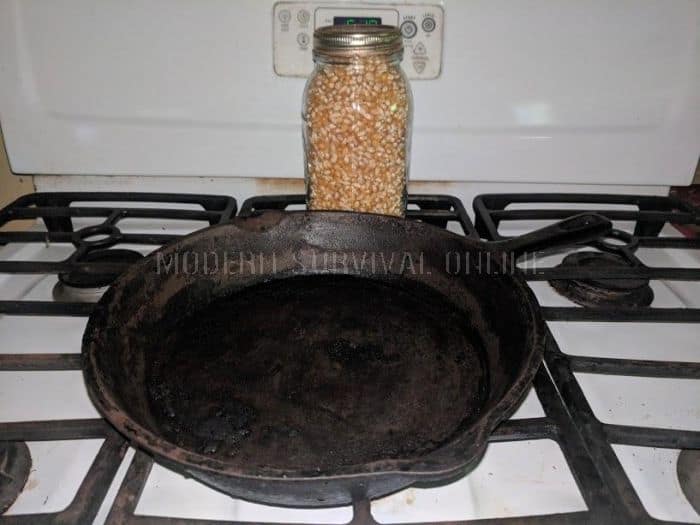
Parched Corn
Anyone who grew up watching or reading Little House on the Prairie books might recall parched corn was one of Laura Ingalls’ favorite treats. It is incredibly simple to make and tastes absolutely delicious.
You can make parched corn from either shelled corn you have cut and dried from cobs you are growing or from frozen corn that you process in your dehydrator or in the oven. To dry frozen corn in a standard kitchen oven, preheat to 150 to 180 degrees. Put the corn on parchment paper on a baking sheet (do not let the kernels touch), and leave the oven door ajar a few inches and bake until it is thoroughly dry.
1. Lightly oil a skillet – vegetable oil, corn oil, coconut oil, olive oil, and almond oil all work equally well.
2. Turn the burner to low to medium heat to warm the oil.
3. When the skillet has gotten slightly hot (the skillet should not get hot enough to fry, just to scorch) carefully pour in a single layer of corn – just enough to cover the bottom of the skillet:
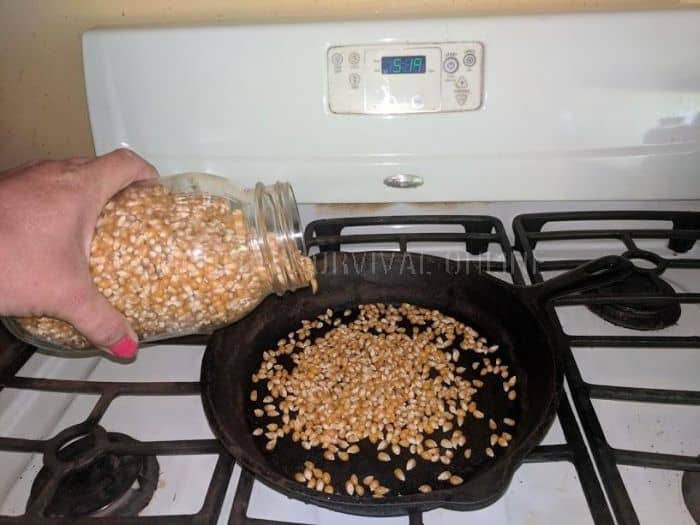
4. Stir the corn over the heat for approximately five minutes – it will start to change color – getting darker as it gets hotter. A few kernels might actually pop and resemble popcorn without all of the fluffy outer covering. The flavor of the corn intensifies as it gets darker in color, but keeping it over the heat too long will burn and ruin the taste:
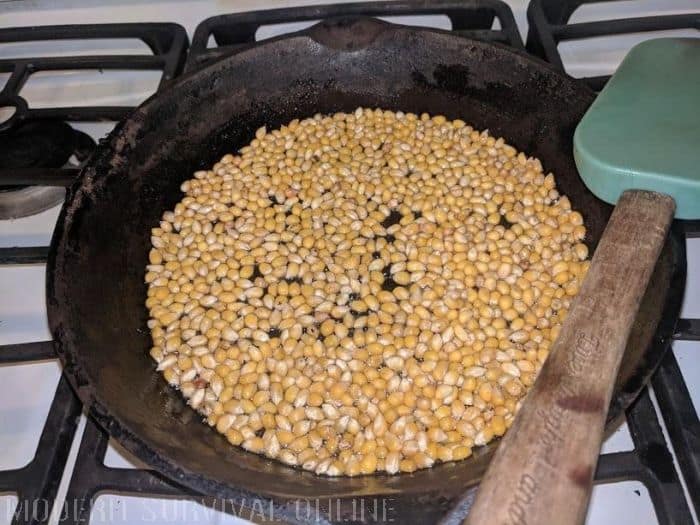
5. Pour the parched corn kernels onto a layer of paper towels to allow the grease to drain.
6. Sprinkle on sugar,salt, butter, or any other seasoning you like and have on hand.
7. This type of survival candy has an incredibly long shelf life and because it is so hardy and lightweight, makes great trail candy or portable snack for folks doing long perimeter patrols:
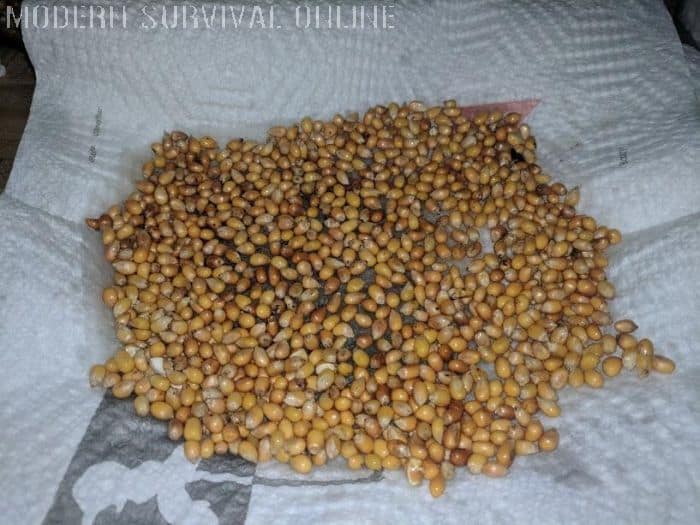
Potato Candy
This pioneer candy recipe should not be reserved until a SHTF situation. Combining peanut butter with potatoes might not sound yummy, but it so is. Peanut butter has an incredibly long shelf life and potatoes are a staple in any garden, so amassing the necessary prime ingredients for this survival candy should not be too difficult or expensive.
Making potato candy is a bit time consuming to make, but once you taste it, I doubt anyone would argue it was not worth all of the effort. We convince my elderly mother to make huge batches of potato candy every year at Christmas, and it always disappears quicker than any of the other sweet treats placed upon the buffet table.
Ingredients
1. 2 tablespoons of milk
2. 1 pinch of salt
3. ¼ of a cup of mashed potatoes – leftover unseasoned mashed potatoes work great
4. 1 teaspoon of vanilla extract
5. ⅓ of a cup of peanut butter
6. 16 ounces of powdered sugar
Directions
1. Mix together the vanilla extract, salt, milk, and mashed potatoes in a bowl.
2. Stir in the powdered sugar.
3. Combine the mixture until a dough consistency is achieved.
4. Refrigerate dough for 60 minutes – or cover with a towel and place in a cool, dry place.
5. Sprinkle the powdered sugar on a piece of wax paper.
6. Roll the dough out onto a baking non-stick baking sheet or cast iron skillet.
7. Spread the peanut butter on top of the dough.
8. Roll the dough into a cinnamon roll shape – gently so the peanut butter does not mush out at the ends any more than absolutely possible.
9. Roll the candy roll in the powdered sugar – sprinkling a little bit extra on top.
10. Chill the dough for 60 minutes once again.
11. Slice the dough and serve cold or at room temperature.
Sponge Candy
Ingredients
• 1 cup of dark corn syrup
• 1 tablespoon of apple cider vinegar
• 1 cup of either brown sugar or granulated sugar – stevia works great also, but cut the amount used by half.
• 1 tablespoon of baking soda
• Chocolate chips, nuts, little candies for topping – optional
Directions
1. Combine the apple cider vinegar, dark corn syrup and the sugar in a pot:
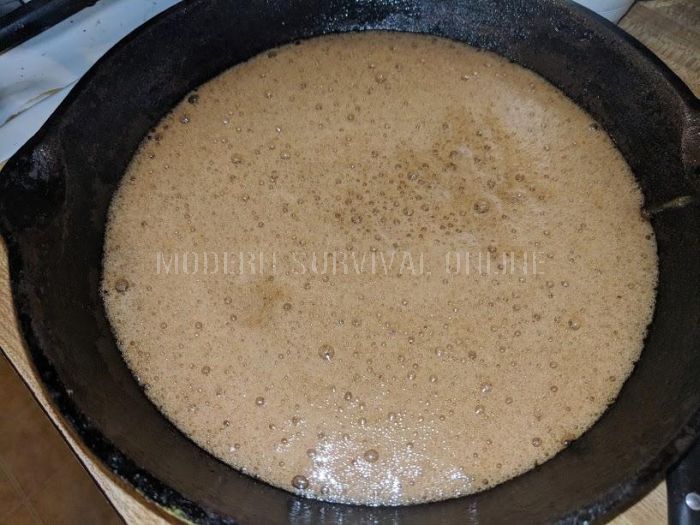
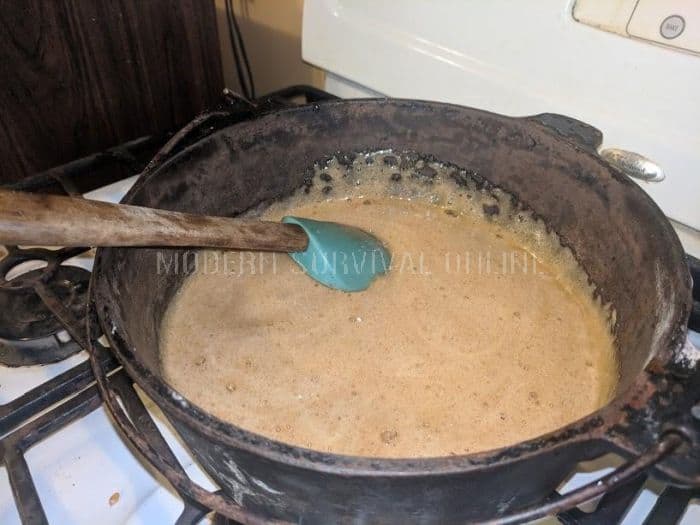
2. Place the pot on the stove and warm over medium heat.
3. Stir continuously until the sugar dissolves to prevent scorching:

4. Stop stirring and only jiggle the pot to prevent scorching while the mixture reaches 300 degrees – check with your candy thermometer.
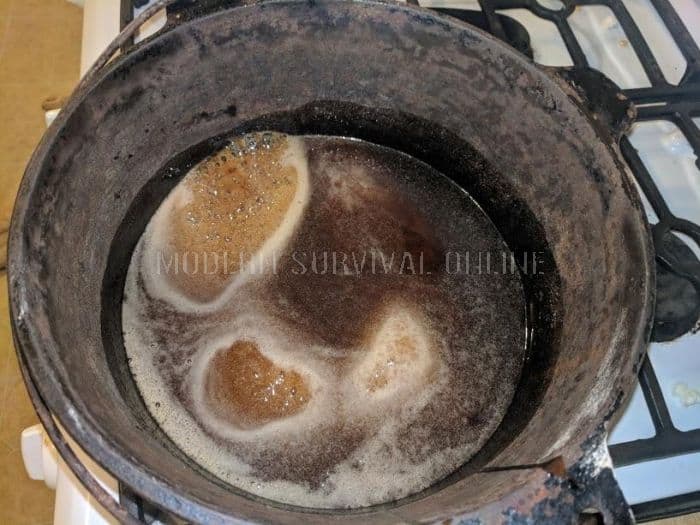
5. Remove the mixture from the stove and pour in the baking soda – it will foam up a lot during the process, it is best to pour in the soda quickly and begin stirring immediately.
6. Pour the mixture on a greased or buttered baking dish. Do not use a spoon to spread out the mixture; allow it to move and fill the dish on its own our the air in the sponge candy will escape and ruin the recipe.
7. Sprinkle sweet chips, nuts, or candies of your choice on the top of the sponge candy now, if you chose to use them. If you spread the sweet or salty bits, do so as lightly as possible.
8. The sponge candy will break into pieces on its own, there is no need to cut it.
You can sprinkle a topping on like I did here with chocolate chips, or melt the topping and pour it over the sponge candy as it cools but before it breaks apart:
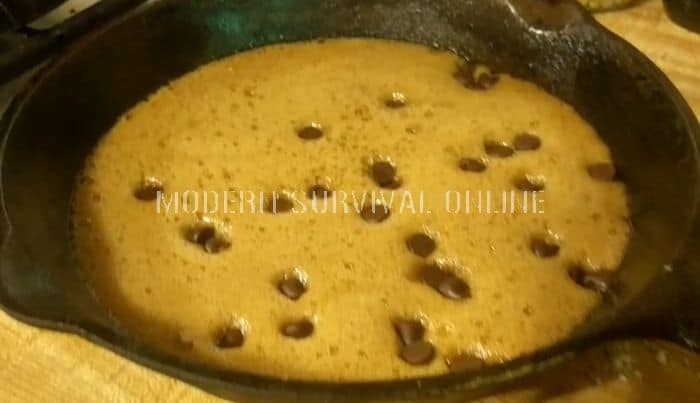
Survival Candy Storage Tips
• Always store candy and and cough drops in airtight containers to prolong shelf life for up to 2 years. Cookies have a shelf life of only a week, but should also be stored in an airtight container. Storing the survival candy in Mason jars or bag that have been vacuum sealed should maximize shelf life.
• To preserve baking chocolate and other sweet or decorative touches to survival candy, cookies, and deserts, store them in vacuum sealed containers as well.
• Moisture is your enemy. Once an airtight container or vacuum sealed bag is opened, the contents inside will be exposed to air and begin the downward spiral to spoiling. Store survival treats in small amounts that will be consumed in a single setting to avoid opening and closing or jars or bags where food remains.
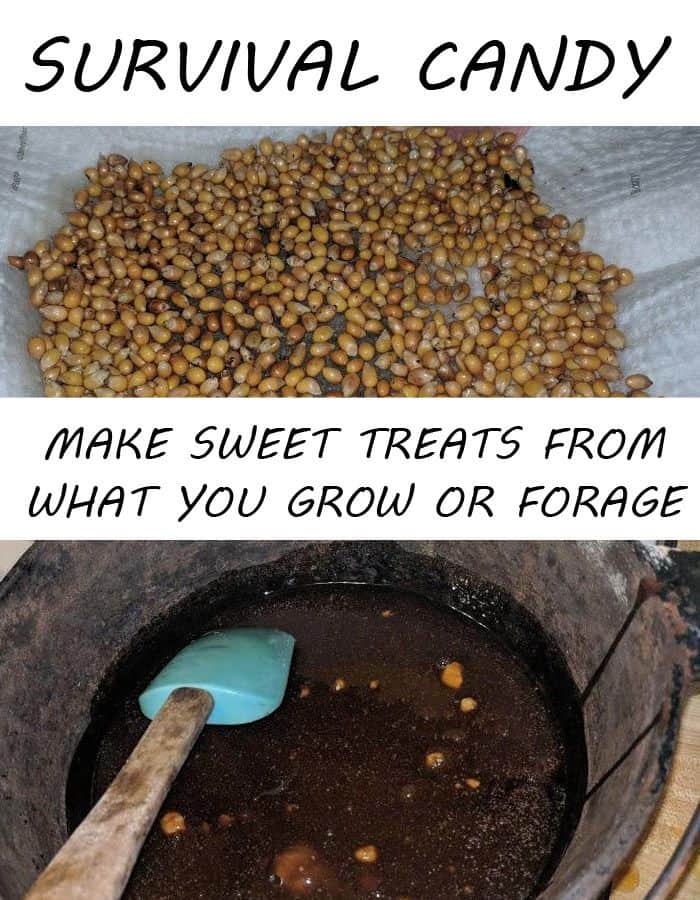
via Modern Survival Online https://ift.tt/2PuUreX
No comments:
Post a Comment